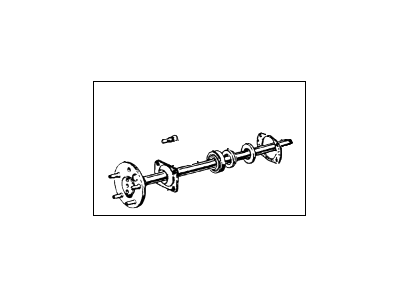

My Garage
My Account
Cart
Genuine Ford F-250 Axle Shaft
Car Axle Shaft- Select Vehicle by Model
- Select Vehicle by VIN
Select Vehicle by Model
orMake
Model
Year
Select Vehicle by VIN
For the most accurate results, select vehicle by your VIN (Vehicle Identification Number).
10 Axle Shafts found
Ford F-250 Shaft Assy - Rear Axle
Part Number: E3TZ-4234-C$176.80 MSRP: $245.60You Save: $68.80 (29%)Ships in 1-2 Business Days
Ford F-250 Axle Shaft
The Axle Shaft in Ford F-250 vehicles help in transmitting torque raised by the differential to the drive wheels so that they spin in an independent fashion for better tractive force during turning. Usually made of long lasting steel, these axle shafts are expected to carry loads of stress and strains that are characteristic of some demanding uses. Yearly, Ford F-250 models have employed and diversified in axle shafts namely, solid axles and halfshafts. Solid axles which incorporate both the differential and axle shafts are typical in trucks while half shafts are used in vehicles having independent suspension. The main distinction lies in their configuration: solid axles are used to give mechanical support as well as transmitting the torque whereas half shafts offer the flexibility to absorb the shocks.
We provide a wide range of Ford F-250 Axle Shaft at the best prices possible. If you need Ford F-250 Axle Shaft, you can shop with confidence on our website. All our OEM parts come with a manufacturer's warranty and are delivered to your door step with a fast delivery service.
Ford F-250 Axle Shaft Parts Questions & Experts Answers
- Q: What does the rear axle assembly consist of and how does it support the Ford F-250's weight?A:The rear axle assembly of a vehicle involves a longitudinal, thin-walled tubular housing that houses a differential and axleshafts, to support the vehicle's sprung weight by using vertical locations of the axle housings on the vehicle frame rails by means of its springs that can be coil, or a leaf spring type. Vehicles utilize two designs of rear axle assemblies: Semi-floating axleshafts and full-floating axleshafts with even more robust construction are other types of axleshafts. A full-floating axleshafts do not carry any of the vehicle mass, may be easily pulled off the tapered roller wheel bearings and are intended solely for power transmission to the rear wheels only. On the other hand, there are 'semi-floating' axleshafts which are parts of the rear wheel support system-they not only transfer power, but also carry part of the vehicle weight. In both designs hypoid gears are used with the pinion gear centre line being below that of the axleshaft centre line. Because of this, it is recommended that work on these models be restricted to specific uses, and for any repair or overhaul requirements, the axle assembly should be removed and brought to a rebuilder or exchanged with new or refurbished ones as buying individual axle parts for repair locally has become quite difficult. When replacing an axle unit, it is thus important that the unit be of the same type, as well as have the same gear ratio.








